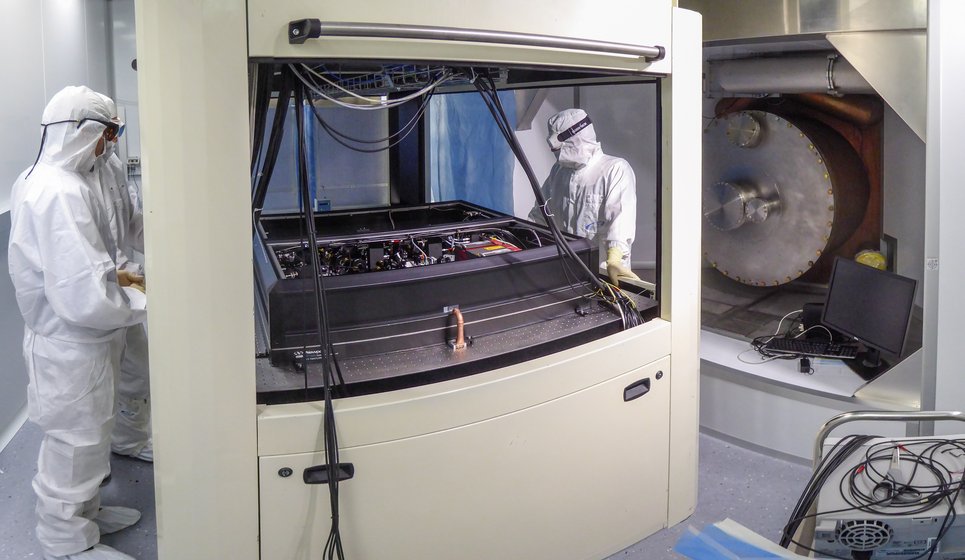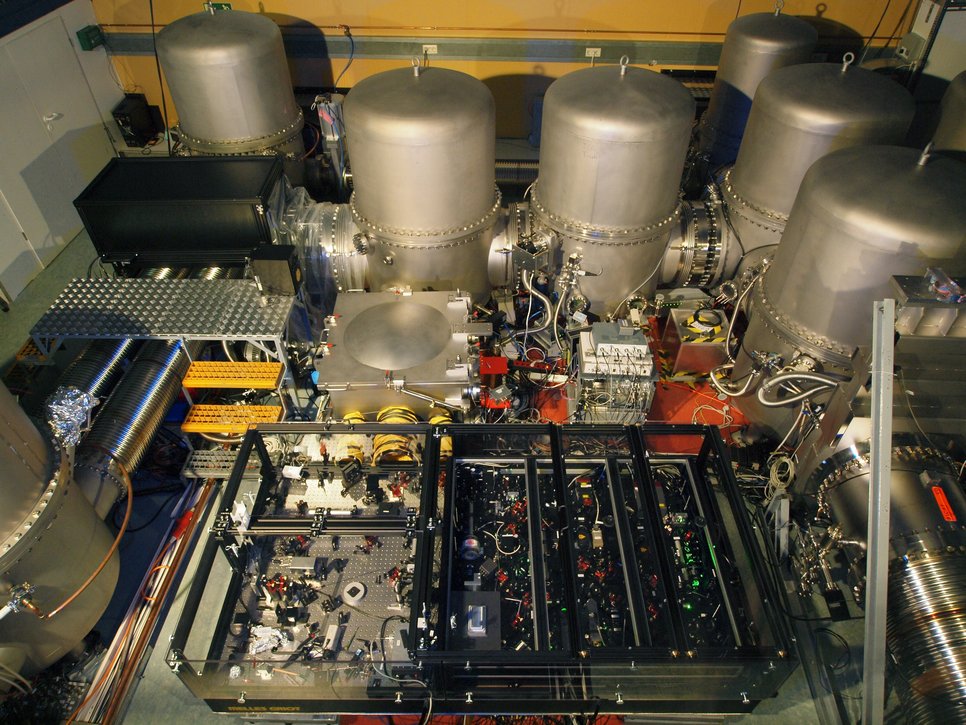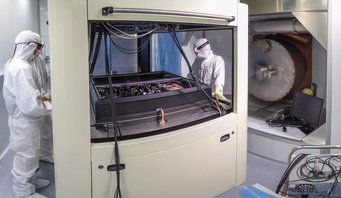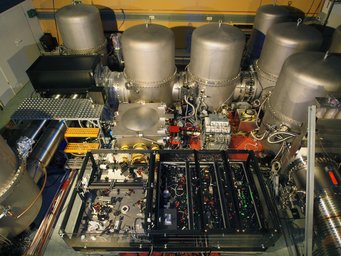Squeezed light makes Virgo’s mirrors jitter
A quantum mechanical effect demonstrated for the first time in the Advanced Virgo gravitational-wave detector
Quantum mechanics does not only describe how the world works on its smallest scales, but also affects the motion of macroscopic objects. An international research team, including four scientists from the MPI for Gravitational Physics (Albert-Einstein-Institut/AEI) and Leibniz University in Hannover, Germany, has shown how they can influence the motion of mirrors, each weighing more than 40 kg, in the Advanced Virgo gravitational-wave detector trough the deliberate use of quantum mechanics. At the core of their experiment published today in Physcial Review Letters is a squeezed-light source, developed and built at the AEI in Hanover, which generates specially tuned laser radiation and improves the detector's measurement sensitivity during observing runs.
The quantum mechanical world of probabilities and uncertainties also governs the behavior of the kilometer-sized gravitational wave detectors Advanced LIGO, Advanced Virgo, and GEO600. The sensitivity of these high-precision instruments to gravitational waves – caused, for example, by distant black hole mergers – is currently limited by quantum mechanical background noise.
Heisenberg's uncertainty limits the detectors
In the detectors, laser light is used to measure with highest precision the relative position of mirrors kilometers apart. Even in the absence of any gravitational-wave signals or noise sources, these mirror position measurements would show a slight jitter.
The reason for this is Heisenberg's uncertainty principle. According to this cornerstone of quantum mechanics, simultaneous measurements of two related quantities are impossible with arbitrary accuracy; they are blurred, or uncertain. However, the measurement inaccuracy of one of the two quantities can be reduced – but only at the expense of a greater inaccuracy when measuring the other quantity.
In gravitational wave detectors shot noise – the patter of the randomly and irregularly arriving light particles – is usually reduced. This trick is necessary because this quantum mechanical background noise limits the sensitivity of the detectors at high measuring frequencies with which they listen into the cosmos.
There ain’t no such thing as a free lunch
According to the uncertainty relation, however, reduced shot noise results in increased radiation pressure noise: The force with which the stream of light particles pushes on the mirrors fluctuates more strongly. As a result, the mirrors move back and forth more, simply because of the effects of quantum mechanics.
“There ain’t no such thing as a free lunch: If you reduce the quantum mechanical background noise at high frequencies using current squeezed-light sources, you pay a price. And this price is increased quantum noise – and thus reduced measurement accuracy – at lower frequencies,” explains Moritz Mehmet, researcher at the AEI Hannover.
Massive mirrors move

Until now, other technical noise sources have hidden this increase in radiation pressure noise in gravitational wave detectors. Only now, during Advanced LIGO’s and Advanced Virgo’s third observation run (April 2019 to March 2020) has this detection become a possibility using squeezed-light sources and reducing other noise sources.
“If we use particularly strongly squeezed light, we clearly see an additional jitter of the 42 kilogram mirrors in the Advanced Virgo detector – really macroscopic objects – at low frequencies. This is due to quantum mechanical effects,” says Henning Vahlbruch, a researcher at the AEI Hannover.
This new measurement is only possible because the researchers are able to determine fluctuations of the mirror positions to less than a thousandth of a proton diameter. Previous measurements of this effect in laboratory experiments used masses that were 10 million times lighter than the Advanced Virgo mirrors.
Squeezed-light pioneer GEO600

Since 2010, the German-British GEO600 detector has been using a squeezed-light source. GEO600 plays a pioneering role in this field. In the third joint observation run (April 2019 until end of March 2020), the two Advanced LIGO detectors and the Advanced Virgo detector also used squeezed light. At the Advanced Virgo instrument, a squeezed-light source developed and built at the AEI Hannover based on the design tested at GEO600 is in use.
In the future, squeezed-light sources will have to be modified to further increase the sensitivity of gravitational-wave detectors. The carefully tuned laser radiation they generate must no longer be the same at all frequencies. Its properties must be adjusted so that it reduces quantum mechanical noise at both high and low frequencies. The development of this frequency-dependent squeezing is already underway in the worldwide community of gravitational wave researchers including GEO600. Two groups have shown first successful experimental demonstrations in spring 2020.

